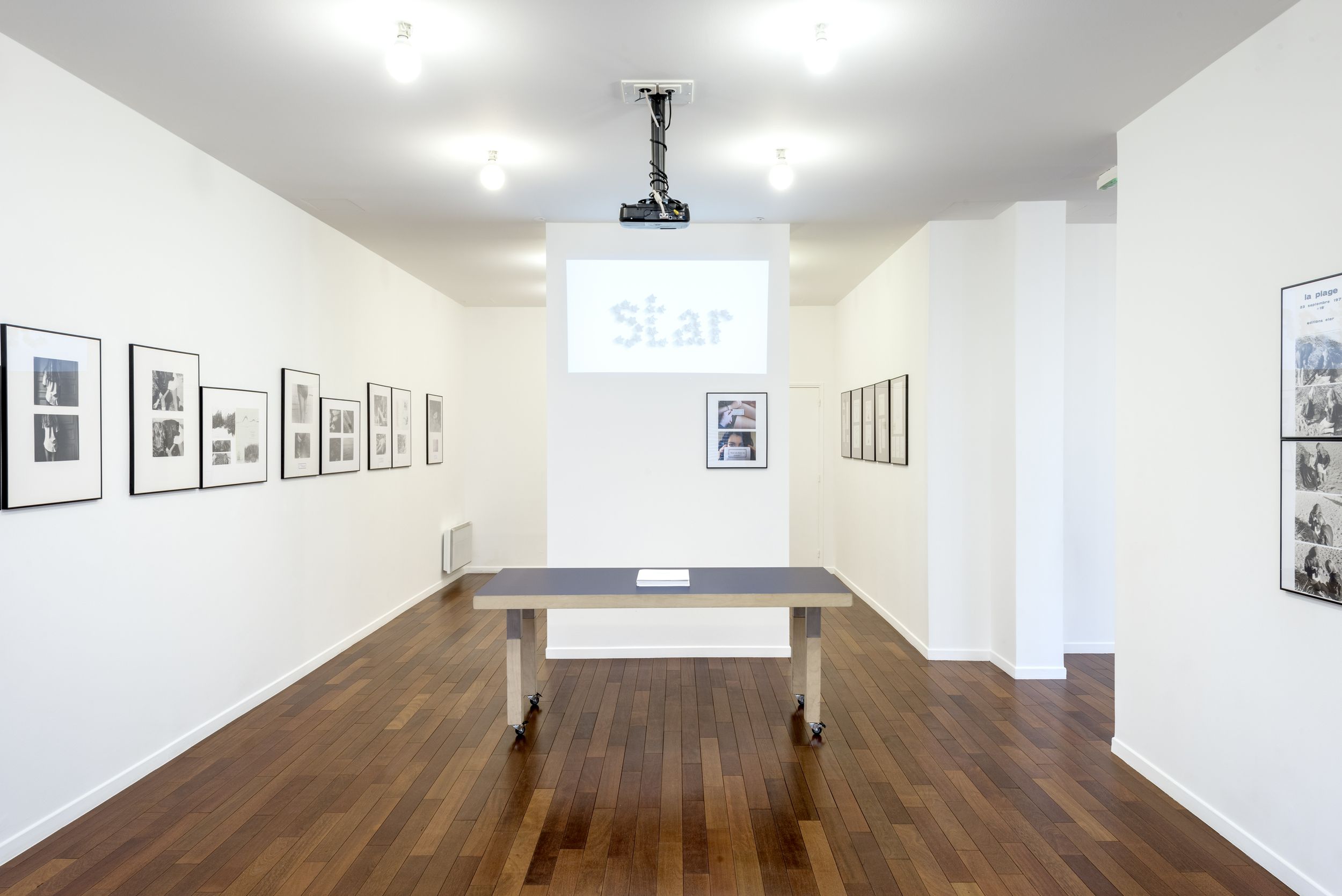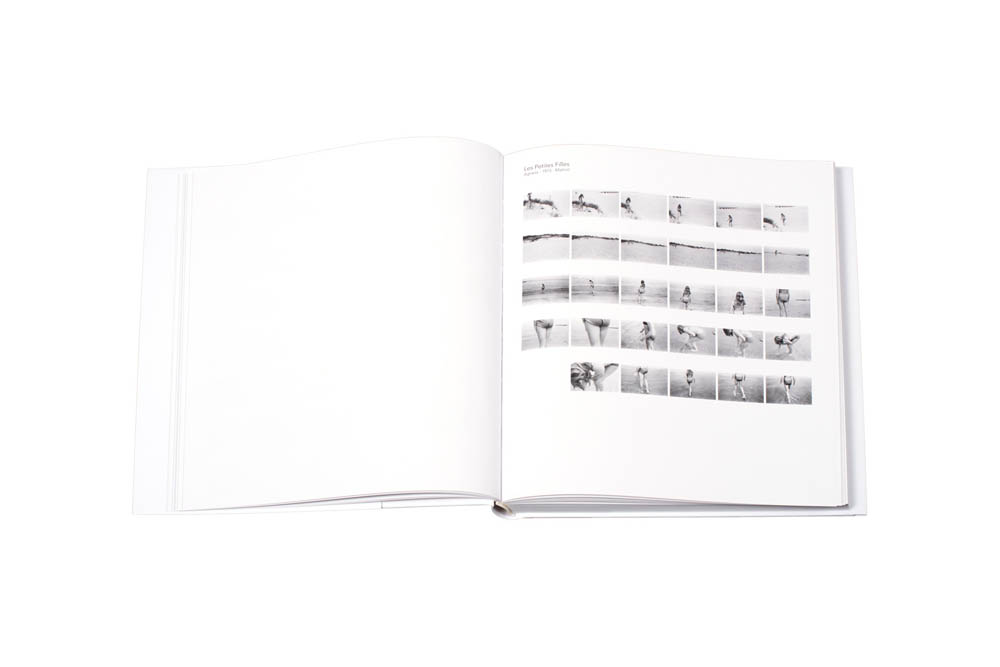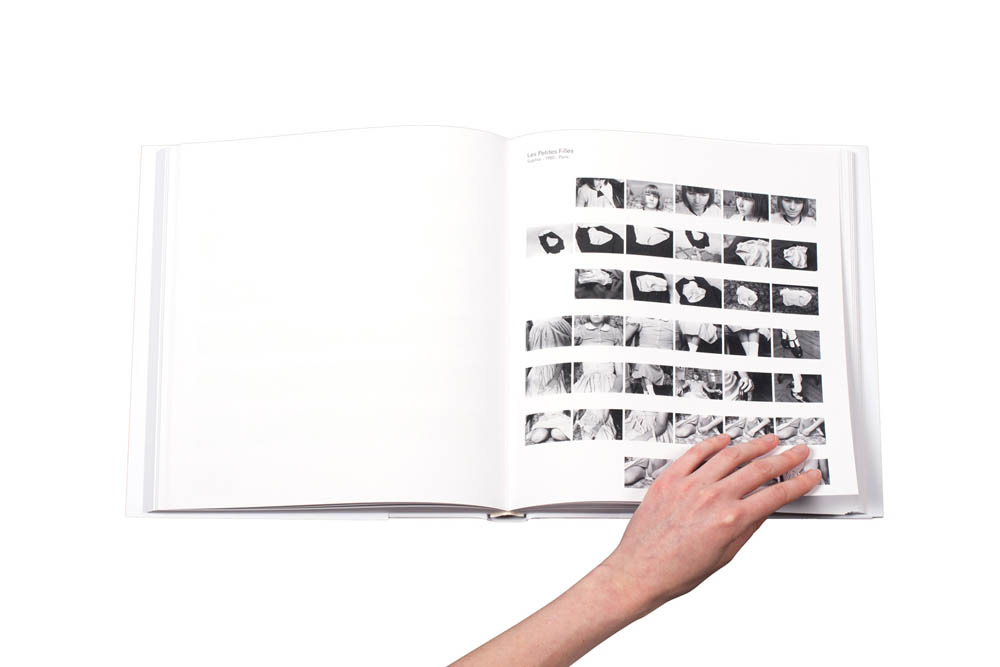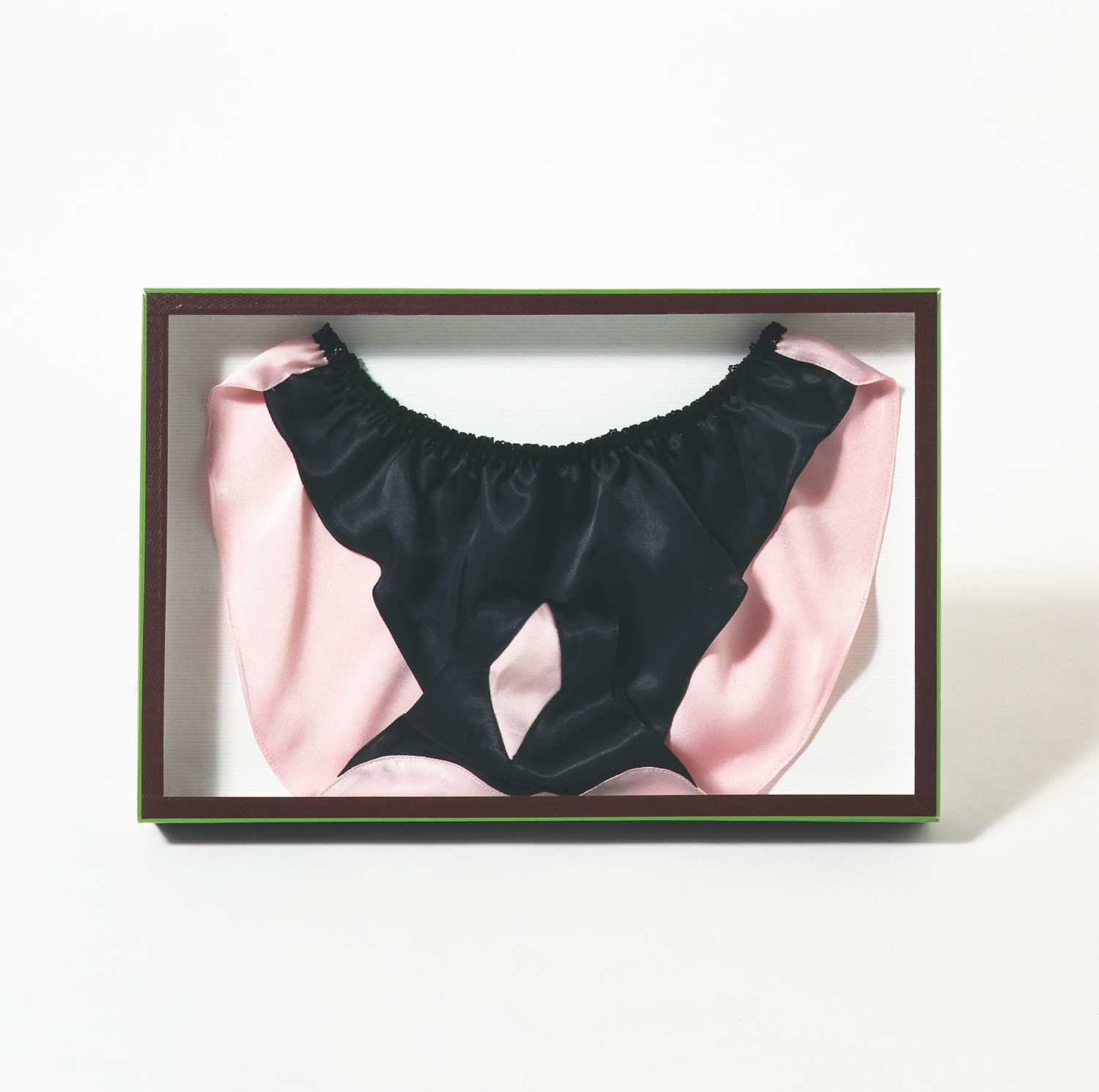Paul-Armand Gette - Cinématographies - Exhibitionmfc-michèle didier | Paris - Brussels - PARIS
Exhibition from April 28 to June 24, 2017
Opening on April 27, 2017 from 6pm to 9pm in presence of the artist
Attentive Observation
Measuring, copying down, making lists, recording, translating, taking photographs... all with complicity!
Since the 1970s, Paul Armand Gette has created a singular body of work rooted in a constant obsession with landscape in relation to the idea of Nature and the positions of models in photographs. As a result, he has created scores of images which he gathers under the name Cinématographies.
Cinématographies is the latest publication released by mfc-michèle didier and is what we could call an "attempt to classify a photographic ensemble". It represents the a collection, an archive built from observation. But what about the subject being observed? What about the "model" we mentioned earlier? Paul Armand Gette is an entomology enthusiast; it is his interest in natural science that prompted him - as an artist - to cast a scientific eye over Nature (which he studies meticulously) and what constitutes it.
Consequently, he undertook the task of photographing young girls in places whose "natural" aspect could be considered as more or less modified. Parks, seaside locations, botanical gardens, bedrooms and living rooms are all used as backdrops for his various studies.
A study of the model, a recurrence of the model.
In addition to the self-evident quality of the images brought together in Gette's Cinématographies, what surfaces is the intimate character of the black and white and/or colour photographs which, appearing one after the other, create as many sequences as inevitable narratives. Young girls are pictured performing gestures which emphasise the "natural" aspect of the surrounding environment. They pick flowers in a park or collect shells on the beach, they name species in a botanical garden or allow their hair to be ruffled by a gentle breeze. The girls point a finger at Nature. But are they not also a part of it?
There are some details which Paul Armand Gette has slipped into his Cinématographies that seem to confirm this idea. The way the framing closes in on the model, the mileage signs glimpsed at in his Les repères series or even the transects we see in the film he named after these immaterial lines. Let us not forget that scientists are always captivated by the object that they study. In opposition to someone like Lewis Carroll, Gette doesn't take boundaries into account and the passing of time will not at all attenuate the relationships he has forged. Still today the call of the model's gaze is answered in a most perfect harmony.
Cinématograpies constitutes a photographical account of Paul Armand Gette's discoveries.
Nathalie, Paris 1970, Agneta, Malmö 1973, Sophie, Paris 1980 or Susannah, Berkeley 1980 are all subjects discovered by the artist over a given period of time..
Incidentally, a strict system of classification is imposed upon them. The girl's name, the year and the place where the photo was taken are meticulously written down and paired with the images in order to form a series. All non-factual data equates to a potential risk. One must stick to the facts observed. And what are these facts other than the gestures performed by young girls in a place that they have chosen to or accepted to be in? Emphasis is placed upon their simple and fleeting actions; in a certain way they are magnified by the quantity of images shot. One is not enough. Seriality reveals. Cezanne's multiple depictions of the Mont Saint-Victoire or Monet's series of haystacks bear witness to this concept.
In order to capture Nathalie, Agneta, Sophie or Susannah in fine detail, Paul Armand Gette multiplies the amount of images taken, just like Etienne-Jules Marey who broke down movements of men walking or insects flying by using chronophotography. The young girl?s state as a "nymph" is too ephemeral to be observed by the naked eye; the onlooker therefore requires time to stand still. Choosing one freeze-frame brings the trick of using serial images to study a phenomenon (a young girl) closer to what spontaneously happens in Nature. It allows the observation made to be as correct as possible.
For Paul Armand Gette who began to publish his entomological research as early as 1945, resorting to scientific methodologies of observation and analysis are a necessity that allows him to take stock of his discoveries before revealing them to potential viewers. The importance of publishing can be appreciated upon opening Cinématographies; on the first page an extract from the bulletin mensuel de la Société Linnéenne de Bruxelles & Paris N°2 - 18e année - 2013-2017 is reproduced and we can read about Tenebria Lupa's presentation regarding the subject Les Petites Filles 1970-1997 (Small Girls 1970-1997) during the Linnean Society's meeting on March 13th 2013.
Delacroix succinctly pointed out that Nature itself is only an idea. Here both artist and scientist know that any experiment involving Nature is inescapably adulterated by the simple fact that Nature itself is - and knows it is - observed. The young girls/models have accepted the idea of a photo shoot, they have even often decided on the location and the outfits or accessories they wear. They also give their permission and approve or disapprove of each photograph taken by the artist. Their involvement in the process is therefore total. More than conscious of the situation, the subjects/models become part and parcel of the photographic method of observation. The role bestowed upon them influences their behaviour. It is thus delusory to expect scientific neutrality from the subject under observation, and it is also just as futile to think that Paul Armand Gette should restrain himself from leaving a shade of his own subjectivity on the so-called object of study.
Measuring, copying down, making lists, recording, translating, taking photographs are all acts which come to reveal the observed as much as the observer. In a state of latent unveiling, resorting to scientific methodology forms an attempt to create detachment. This is one ongoing experiment that Paul Armand Gette is, apparently, not ready to conclude
Exhibition from April 28 to June 24, 2017
Opening on April 27, 2017 from 6pm to 9pm in presence of the artist
Attentive Observation
Measuring, copying down, making lists, recording, translating, taking photographs... all with complicity!
Since the 1970s, Paul Armand Gette has created a singular body of work rooted in a constant obsession with landscape in relation to the idea of Nature and the positions of models in photographs. As a result, he has created scores of images which he gathers under the name Cinématographies.
Cinématographies is the latest publication released by mfc-michèle didier and is what we could call an "attempt to classify a photographic ensemble". It represents the a collection, an archive built from observation. But what about the subject being observed? What about the "model" we mentioned earlier? Paul Armand Gette is an entomology enthusiast; it is his interest in natural science that prompted him - as an artist - to cast a scientific eye over Nature (which he studies meticulously) and what constitutes it.
Consequently, he undertook the task of photographing young girls in places whose "natural" aspect could be considered as more or less modified. Parks, seaside locations, botanical gardens, bedrooms and living rooms are all used as backdrops for his various studies.
A study of the model, a recurrence of the model.
In addition to the self-evident quality of the images brought together in Gette's Cinématographies, what surfaces is the intimate character of the black and white and/or colour photographs which, appearing one after the other, create as many sequences as inevitable narratives. Young girls are pictured performing gestures which emphasise the "natural" aspect of the surrounding environment. They pick flowers in a park or collect shells on the beach, they name species in a botanical garden or allow their hair to be ruffled by a gentle breeze. The girls point a finger at Nature. But are they not also a part of it?
There are some details which Paul Armand Gette has slipped into his Cinématographies that seem to confirm this idea. The way the framing closes in on the model, the mileage signs glimpsed at in his Les repères series or even the transects we see in the film he named after these immaterial lines. Let us not forget that scientists are always captivated by the object that they study. In opposition to someone like Lewis Carroll, Gette doesn't take boundaries into account and the passing of time will not at all attenuate the relationships he has forged. Still today the call of the model's gaze is answered in a most perfect harmony.
Cinématograpies constitutes a photographical account of Paul Armand Gette's discoveries.
Nathalie, Paris 1970, Agneta, Malmö 1973, Sophie, Paris 1980 or Susannah, Berkeley 1980 are all subjects discovered by the artist over a given period of time..
Incidentally, a strict system of classification is imposed upon them. The girl's name, the year and the place where the photo was taken are meticulously written down and paired with the images in order to form a series. All non-factual data equates to a potential risk. One must stick to the facts observed. And what are these facts other than the gestures performed by young girls in a place that they have chosen to or accepted to be in? Emphasis is placed upon their simple and fleeting actions; in a certain way they are magnified by the quantity of images shot. One is not enough. Seriality reveals. Cezanne's multiple depictions of the Mont Saint-Victoire or Monet's series of haystacks bear witness to this concept.
In order to capture Nathalie, Agneta, Sophie or Susannah in fine detail, Paul Armand Gette multiplies the amount of images taken, just like Etienne-Jules Marey who broke down movements of men walking or insects flying by using chronophotography. The young girl?s state as a "nymph" is too ephemeral to be observed by the naked eye; the onlooker therefore requires time to stand still. Choosing one freeze-frame brings the trick of using serial images to study a phenomenon (a young girl) closer to what spontaneously happens in Nature. It allows the observation made to be as correct as possible.
For Paul Armand Gette who began to publish his entomological research as early as 1945, resorting to scientific methodologies of observation and analysis are a necessity that allows him to take stock of his discoveries before revealing them to potential viewers. The importance of publishing can be appreciated upon opening Cinématographies; on the first page an extract from the bulletin mensuel de la Société Linnéenne de Bruxelles & Paris N°2 - 18e année - 2013-2017 is reproduced and we can read about Tenebria Lupa's presentation regarding the subject Les Petites Filles 1970-1997 (Small Girls 1970-1997) during the Linnean Society's meeting on March 13th 2013.
Delacroix succinctly pointed out that Nature itself is only an idea. Here both artist and scientist know that any experiment involving Nature is inescapably adulterated by the simple fact that Nature itself is - and knows it is - observed. The young girls/models have accepted the idea of a photo shoot, they have even often decided on the location and the outfits or accessories they wear. They also give their permission and approve or disapprove of each photograph taken by the artist. Their involvement in the process is therefore total. More than conscious of the situation, the subjects/models become part and parcel of the photographic method of observation. The role bestowed upon them influences their behaviour. It is thus delusory to expect scientific neutrality from the subject under observation, and it is also just as futile to think that Paul Armand Gette should restrain himself from leaving a shade of his own subjectivity on the so-called object of study.
Measuring, copying down, making lists, recording, translating, taking photographs are all acts which come to reveal the observed as much as the observer. In a state of latent unveiling, resorting to scientific methodology forms an attempt to create detachment. This is one ongoing experiment that Paul Armand Gette is, apparently, not ready to conclude
Exposed artworks
Set containing a book, 252 pages and one unique photographic print
10.24 x 11.42 in ( 26 x 29,5 cm )
Insect box, Museum model, contains a pair of pink and black panties
14.17 x 15.35 x 1.97 in ( 36 x 39 x 5,5 cm cm )
Book, 252 pages
10.24 x 11.42 in ( 26 x 29,5 cm )























